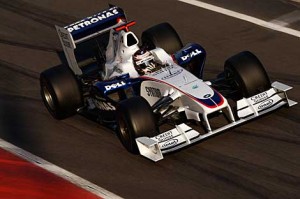What’s changing in 2009?
 2009 will see some of the biggest regulation changes in Formula Ones history. Along with the introduction of the new KERS technology almost every aerodynamic part will be affected. So what exactly is changing? Well, you can read the full 63 page FIA document, but here’s a summary of the main changes:
2009 will see some of the biggest regulation changes in Formula Ones history. Along with the introduction of the new KERS technology almost every aerodynamic part will be affected. So what exactly is changing? Well, you can read the full 63 page FIA document, but here’s a summary of the main changes:
- Slick tyres
- In an attempt to control the ever-increasing speeds in Formula One, slick tyres were banned in 1998. Due to developments in other areas though this had a limited affect and 2009 will see the re-introduction of slicks to Formula One. It’s about time.
- Aerodynamics
- There have been big aerodynamic changes made in an attempt to promote overtaking. The rear wing is much higher and narrower while the front wing is lower and wider. All the amazing little deflectors, hydrofoils and flick-ups that the cars have sprouted over the last season will be removed. According to McLaren’s Director of Engineering, Paddy Lowe, when the ’09 car first went into the wind tunnel they had lost over 50 per cent of downforce. While removing some of the appendages like the “horns” that Honda used will improve the look of the cars I can’t help thinking the new wings make them look just a bit less pretty. Maybe I’m just not used to it yet and if it helps following cars to get close enough to overtake more then that can only be a good thing.
- Kinetic Energy Recovery System (KERS)
- These devices store energy created under braking. This energy can then be converted into power at the touch of a button giving a short boost of up to 80hp. There are two types of KERS systems; one which uses a flywheel (storing mechanical energy) and one using a battery or supercapacitor (storing electrical energy). These won’t be compulsory in 2009 so it may be that some teams at least start the season without the technology especially considering the incidents that some teams have had; Red Bull had a fire in their factory caused by a KERS device and a BMW Sauber mechanic was given an electric shock when he touched a KERS-equipped car in testing at Jerez.
- Engines
- From 2009, engine life will be extended from two to three races however FIA President Max Mosley is now also pushing plans to introduce standardised engines in 2010, possibly supplied by Cosworth. This cost-cutting move has been criticised by drivers and teams alike with both Fernando Alonso and Ferrari saying they could quit if a standard engine was introduced. Teams have until this Thursday to notify the FIA if they want to use the Cosworth engine. I doubt any will take up the offer.
- Team budgets
- Rather than trying to constrain the teams’ spending through ever more regulations, the FIA has decided to just put a cap on expenditure for all Formula One costs other than engines, drivers and expenditure exclusively for promotion and marketing. The expenditure for the 2009 season will be capped at $268 million. This will drop to $214 million in 2010 and finally settle on $170 million from 2011. This is significantly less than the $400 million or so the biggest teams spent in 2008.
- Driver Adjustable Bodywork
- This is an intesting one. Article 3.18 of the Regulations states “A single closed section situated each side of car centre line… is allowed to change incidence while the vehicle is in motion within a maximum range of 6 degrees… a maximum of two adjustments may be made within any single lap of a circuit”. So a driver can take some wing off for more speed in the straights and add some wing for the corners. But only twice per lap. I’m not sure what the point of limiting the number of adjustments per lap is. It just seems to make what seems a fairly complicated setup even more so.
Will these new regulations lower costs and increase overtaking? It remains to be seen. Decreasing the aerodynamic downforce takes away some grip but the slick tyres give significantly more grip than the grooved tyres of 2008 so really it’s a move away from aerodynamic grip towards mechanical grip. Will they just cancel each other out?
A cap on budgets will obviously lower costs but I think a standardised engine is a bad move. It’s not just the best drivers competing on the track that makes Formula One special, it’s also the best engineers competing in the factory to produce the fastest car. Similar to the crazy situation we had in 2005 when tyre changes were banned, if we take away this part of the sport it actually becomes less interesting not more.
I don’t think we’ll really know how successful the changes have been until we get to Melbourne.